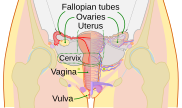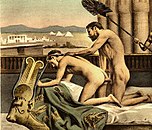The following selected articles appear on Portal:Human sexuality. The layout for new additions is at Portal:Human sexuality/Selected article/Layout.
- Current number of selected articles: 39. (Click here to update this number if you add more articles.)
Selected article 1
Portal:Human sexuality/Selected article/1 Bisexuality is romantic attraction, sexual attraction or sexual behavior toward both males and females, and may also encompass romantic or sexual attraction to people of any gender identity or to a person irrespective of that person's biological sex or gender, which is sometimes termed pansexuality.
The term bisexuality is mainly used in the context of human attraction to denote romantic or sexual feelings toward both men and women, and the concept is one of the three main classifications of sexual orientation along with heterosexuality and homosexuality, which are each parts of the heterosexual–homosexual continuum. A bisexual identity does not necessarily equate to equal sexual attraction to both sexes; commonly, people who have a distinct but not exclusive sexual preference for one sex over the other also identify themselves as bisexual.
Bisexuality has been observed in various human societies and elsewhere in the animal kingdom throughout recorded history. The term bisexuality, however, like the terms hetero- and homosexuality, was coined in the 19th century. (Full article...)
Selected article 2
Portal:Human sexuality/Selected article/2
Heterosexuality is romantic attraction, sexual attraction or sexual behavior between persons of opposite sex or gender in the gender binary. As a sexual orientation, heterosexuality is "an enduring pattern of emotional, romantic, and/or sexual attractions" to persons of the opposite sex; it "also refers to a person's sense of identity based on those attractions, related behaviors, and membership in a community of others who share those attractions."Heterosexuality is one of the three main classifications of sexual orientation along with bisexuality and homosexuality, which are each parts of the heterosexual–homosexual continuum.
The term heterosexual or heterosexuality is usually applied to humans, but it is also observed in all mammals. The word heterosexual is etymologically formed by adding the combining form of Greek έτερος heteros (meaning "different" or "other") as a prefix to "sexuality". (Full article...)
Selected article 3
Portal:Human sexuality/Selected article/3
Homosexuality (from Ancient Greek ὁμός 'same', and Latin sexus 'sex') is romantic attraction, sexual attraction or sexual behavior between members of the same sex or gender. As a sexual orientation, homosexuality is "an enduring pattern of emotional, romantic, and/or sexual attractions" primarily or exclusively to people of the same sex. It "also refers to a person's sense of identity based on those attractions, related behaviors, and membership in a community of others who share those attractions."Along with bisexuality and heterosexuality, homosexuality is one of the three main categories of sexual orientation within the heterosexual–homosexual continuum. There is no consensus among scientists about why a person develops a particular sexual orientation; however, biologically-based theories for the cause of sexual orientation are favored by experts, which point to genetic factors, the early uterine environment, or both in combination. There is no substantive evidence which suggests parenting or early childhood experiences play a role when it comes to sexual orientation; when it comes to same-sex sexual behavior, shared or familial environment plays no role for men and minor role for women. While some hold the view that homosexual activity is unnatural, research has shown that homosexuality is an example of a normal and natural variation in human sexuality and is not in and of itself a source of negative psychological effects. Most people experience little or no sense of choice about their sexual orientation. There is insufficient evidence to support the use of psychological interventions to change sexual orientation. (Full article...)
Selected article 4
Portal:Human sexuality/Selected article/4 Asexuality (or nonsexuality) is the lack of sexual attraction to anyone, or low or absent interest in sexual activity. It may be considered the lack of a sexual orientation, or one of the four variations thereof, alongside heterosexuality, homosexuality, and bisexuality. A study in 2004 placed the prevalence of asexuality at 1% in the British population.
Asexuality is distinct from abstention from sexual activity and from celibacy, which are behavioral and generally motivated by factors such as an individual's personal or religious beliefs; sexual orientation, unlike sexual behavior, is believed to be "enduring." Some asexual people engage in sexual activity despite lacking a desire for sex or sexual attraction, due to a variety of reasons, such as a desire to please romantic partners or a desire to have children.
Acceptance of asexuality as a sexual orientation and field of scientific research is still relatively new, as a growing body of research from both sociological and psychological perspectives has begun to develop. While some researchers assert that asexuality is a sexual orientation, other researchers disagree. (Full article...)
Selected article 5
Portal:Human sexuality/Selected article/5
A condom (/ˈkɒndəm/ or UK: /ˈkɒndɒm/) is a barrier device commonly used during sexual intercourse to reduce the probability of pregnancy and spreading sexually transmitted infections (STIs/STDs) such as HIV/AIDS. It is put on an erect penis and physically blocks ejaculated semen from entering the body of a sexual partner. Condoms are also used for collection of semen for use in infertility treatment. In the modern age, condoms are most often made from latex, but some are made from other materials such as polyurethane, polyisoprene, or lamb intestine. A female condom is also available, often made of nitrile.As a method of birth control, male condoms have the advantages of being inexpensive, easy to use, having few side effects, and offering protection against sexually transmitted diseases. With proper knowledge and application technique—and use at every act of intercourse—women whose partners use male condoms experience a 2% per-year pregnancy rate with perfect use and an 18% per-year pregnancy rate with typical use. Condoms have been used for at least 400 years. Since the 19th century, they have been one of the most popular methods of contraception in the world. While widely accepted in modern times, condoms have generated some controversy, primarily over what role they should play in sex education classes. (Full article...)
Selected article 6
Portal:Human sexuality/Selected article/6
A female condom (also known as a femidom) is a device that is used during sexual intercourse as a barrier contraceptive and to reduce the risk of sexually transmitted infections (STIs—such as gonorrhea, syphilis, and HIV) though its protection against them is inferior to that by male condoms and unintended pregnancy. Invented by Danish MD Lasse Hessel, it is worn internally by the female partner and provides a physical barrier to prevent exposure to ejaculated semen or other body fluids. Female condoms can be used by the receptive partner during anal sex.The female condom is a thin, soft, loose-fitting sheath with a flexible ring at each end. They typically come in various sizes. For most vaginas, a moderately sized condom is adequate; women who have recently given birth should try a large first. The inner ring at the closed end of the sheath is used to insert the condom inside the vagina and to hold it in place during intercourse. The rolled outer ring at the open end of the sheath remains outside the vagina and covers part of the external genitalia. (Full article...)
Selected article 7
Portal:Human sexuality/Selected article/7
The Kama Sutra (Sanskrit: कामसूत्र ⓘ, Kāmasūtra) is an ancient Indian Hindu text widely considered to be the standard work on human sexual behavior in Sanskrit literature written by Vātsyāyana. A portion of the work consists of practical advice on sexual intercourse. It is largely in prose, with many inserted anustubh poetry verses. "Kāma" which is one of the four goals of Hindu life, means desire including sexual desire the latter being the subject of the textbook, and "sūtra" literally means a thread or line that holds things together, and more metaphorically refers to an aphorism (or line, rule, formula), or a collection of such aphorisms in the form of a manual. Contrary to popular perception, especially in the western world, Kama sutra is not just an exclusive sex manual; it presents itself as a guide to a virtuous and gracious living that discusses the nature of love, family life and other aspects pertaining to pleasure oriented faculties of human life. (Full article...)Selected article 8
Portal:Human sexuality/Selected article/8
Female genital mutilation (FGM), also known as female genital cutting and female circumcision, is the ritual removal of some or all of the external female genitalia. Typically carried out by a traditional circumciser with a blade or razor, with or without anaesthesia, FGM is practised by ethnic groups in 27 countries in sub-Saharan and north-east Africa, in Yemen and Iraqi Kurdistan, and to a lesser extent elsewhere in Asia and within immigrant communities around the world.For the 29 countries in which it is concentrated, The age at which it is conducted varies from days after birth to puberty; in half the countries for which national figures were available in 2000–2010, most girls were cut before the age of five. (Full article...)
Selected article 9
Portal:Human sexuality/Selected article/9
The age of consent is the age at which a person is considered to be legally competent to consent to sexual acts, and is thus the minimum age of a person with whom another person is legally permitted to engage in sexual activity. The distinguishing aspect of the age of consent laws is that the person below the minimum age is regarded as the victim, and their sex partner as the offender.The term age of consent rarely actually appears in legal statutes; it has sometimes been used with other meanings, such as the age at which a person becomes competent to consent to marriage, but the meaning given above is the one now generally understood. It should not be confused with the age of majority, age of criminal responsibility, the voting age, the drinking age, driving age, etc.
Age of consent laws vary widely from jurisdiction to jurisdiction, though most jurisdictions set the age of consent in the range 14 to 18. The laws may also vary by the type of sexual act, the gender of the actors, or other restrictions such as abuse of a position of trust. Some jurisdictions may also make allowances for minors engaged in sexual acts with each other, rather than a single age. Charges resulting from a breach of these laws may range from a misdemeanor such as corruption of a minor, to what is popularly called statutory rape (which is considered equivalent to rape, both in severity and sentencing).
There are many "gray areas" in this area of law, some regarding unspecific and untried legislation, others brought about by debates regarding changing societal attitudes, and others due to conflicts between federal and state laws. These factors all make age of consent an often confusing subject, and a topic of highly charged debates. (Full article...)
Selected article 10
Portal:Human sexuality/Selected article/10
BDSM is a variety of erotic practices involving dominance and submission, role-playing, restraint, among other practices. The practices exist within the BDSM community and in the general population.The term BDSM dates back to 1969; however, the origin of the term BDSM is unclear and is believed to have been formed either from joining the term B&D (bondage and discipline) with S&M (sadomasochism or sadism and masochism), or as a compound initialism from B&D, D&S (dominance and submission), and S&M. Regardless of its origin, BDSM is used as a catch-all phrase to include a wide range of activities and distinct subcultures. (Full article...)
Selected article 11
Portal:Human sexuality/Selected article/11
Prostitution of children or child prostitution is prostitution involving a child. It is a form of commercial sexual exploitation of children. The term normally refers to prostitution of a minor, or person under the legal age of maturity. In most jurisdictions, prostitution of or by a person under 18 is illegal, even if the child is older than the statutory age of consent of the jurisdictions. In some jurisdictions child prostitution is illegal as part of a general prohibition on prostitution.Prostitution of children usually manifests in the form of sex trafficking, in which a child is kidnapped or duped into becoming involved in the sex trade, or "survival sex", in which the child engages in sexual activities to procure basic essentials such as food and shelter. Prostitution of children is commonly associated with child pornography, and they often overlap. Some people travel to foreign countries to engage in child sex tourism. Research suggests that there may be as many as 10 million children involved in prostitution worldwide. The problem is most severe in South America and Asia, but prostitution of children exists globally, in undeveloped countries as well as developed. (Full article...)
Selected article 12
Portal:Human sexuality/Selected article/12
Margaret Higgins Sanger (September 14, 1879 – September 6, 1966) was an American birth control activist, sex educator, and nurse. Sanger popularized the term birth control, opened the first birth control clinic in the United States, and established organizations that evolved into the Planned Parenthood Federation of America. Sanger's efforts contributed to several judicial cases that helped legalize contraception in the United States. Sanger is a frequent target of criticism by opponents of birth control and has also been criticized for supporting eugenics, but remains an iconic figure in the American reproductive rights movement.In 1916, Sanger opened the first birth control clinic in the United States, which led to her arrest for distributing information on contraception. Her subsequent trial and appeal generated enormous support for her cause. Sanger felt that in order for women to have a more equal footing in society and to lead healthier lives, they needed to be able to determine when to bear children. She also wanted to prevent unsafe abortions, so-called back-alley abortions, which were common at the time because abortions were usually illegal.
In 1921, Sanger founded the American Birth Control League, which later became the Planned Parenthood Federation of America. In New York City, she organized the first birth control clinic staffed by all-female doctors, as well as a clinic in Harlem with an entirely African-American staff. In 1929, she formed the National Committee on Federal Legislation for Birth Control, which served as the focal point of her lobbying efforts to legalize contraception in the United States. From 1952 to 1959, Sanger served as president of the International Planned Parenthood Federation. She died in 1966, and is widely regarded as a founder of the modern birth control movement. (Full article...)
Selected article 13
Portal:Human sexuality/Selected article/13 Transgender is the state of one's gender identity or gender expression not matching one's assigned sex. Transgender is independent of sexual orientation; transgender people may identify as heterosexual, homosexual, bisexual, etc; some may consider conventional sexual orientation labels inadequate or inapplicable to them. The definition of transgender includes:
- "Of, relating to, or designating a person whose identity does not conform unambiguously to conventional notions of male or female gender roles, but combines or moves between these."
- "People who were assigned a sex, usually at birth and based on their genitals, but who feel that this is a false or incomplete description of themselves."
- "Non-identification with, or non-presentation as, the sex (and assumed gender) one was assigned at birth." (Full article...)
Selected article 14
Portal:Human sexuality/Selected article/14 Polyamory (from Greek πολύ poly, "many, several", and Latin amor, "love") is the practice, desire, or acceptance of having more than one intimate relationship at a time with the knowledge and consent of everyone involved. It is distinct from swinging (which emphasizes sex with others as merely recreational) and may or may not include polysexuality (attraction towards multiple genders and/or sexes).
Polyamory, often abbreviated as poly, is often described as "consensual, ethical, and responsible non-monogamy." The word is sometimes used in a broader sense to refer to sexual or romantic relationships that are not sexually exclusive, though there is disagreement on how broadly it applies; an emphasis on ethics, honesty, and transparency all around is widely regarded as the crucial defining characteristic. (Full article...)
Selected article 15
Portal:Human sexuality/Selected article/15 Paraphilia is the experience of intense sexual arousal to atypical objects, situations, or individuals. No consensus has been found for any precise border between unusual personal sexual tastes and paraphilic ones. There is debate over which, if any, of the paraphilias should be listed in diagnostic manuals, such as the Diagnostic and Statistical Manual of Mental Disorders (DSM) or the International Classification of Diseases.
The number and taxonomy of paraphilias is under debate; one source lists as many as 549 types of paraphilias. Several sub-classifications of the paraphilias have been proposed, and some argue that a fully dimensional, spectrum or complaint-oriented approach would better reflect the evidence. (Full article...)
Selected article 16
Portal:Human sexuality/Selected article/16
Safe sex is sexual activity engaged in by people who have taken precautions to protect themselves against sexually transmitted infections (STIs) such as HIV/AIDS. It is also referred to as safer sex or protected sex, while unsafe or unprotected sex is sexual activity engaged in without precautions. Some sources prefer the term safer sex to more precisely reflect the fact that these practices reduce, but do not completely eliminate, the risk of disease transmission. The term sexually transmitted infections (STIs) has gradually become preferred over sexually transmitted diseases (STDs) among medical sources, as it has a broader range of meaning; a person may be infected, and may potentially infect others, without showing signs of disease. (Full article...)Selected article 17
Portal:Human sexuality/Selected article/17 Sexual orientation is an enduring personal quality that inclines people to feel romantic or sexual attraction (or a combination of these) to persons of the opposite sex or gender, the same sex or gender, or to both sexes or more than one gender. These attractions are generally subsumed under heterosexuality, homosexuality, and bisexuality, while asexuality (the lack of sexual attraction to others) is sometimes identified as the fourth category. These categories are aspects of the more nuanced nature of sexual identity. For example, people may use other labels, such as pansexual or polysexual, or none at all. According to the American Psychological Association, sexual orientation "also refers to a person's sense of identity based on those attractions, related behaviors, and membership in a community of others who share those attractions". (Full article...)
Selected article 18
Portal:Human sexuality/Selected article/18
Alfred Charles Kinsey (June 23, 1894 – August 25, 1956) was an American biologist, professor of entomology and zoology, and sexologist who in 1947 founded the Institute for Sex Research at Indiana University, now known as the Kinsey Institute for Research in Sex, Gender, and Reproduction. He is best known for writing Sexual Behavior in the Human Male (1948) and Sexual Behavior in the Human Female (1953), also known as the Kinsey Reports, as well as the Kinsey scale. Kinsey's research on human sexuality, foundational to the field of sexology, provoked controversy in the 1940s and 1950s. His work has influenced social and cultural values in the United States, as well as internationally. (Full article...)Selected article 19
Portal:Human sexuality/Selected article/19
Sexual intercourse, or coitus or copulation, is chiefly the insertion and thrusting of a male's penis, usually when erect, into a female's vagina for the purposes of sexual pleasure or reproduction; also known as vaginal intercourse or vaginal sex. Other forms of penetrative sexual intercourse include penetration of the anus by the penis (anal sex), penetration of the mouth by the penis or oral penetration of the vulva or vagina (oral sex), sexual penetration by the fingers (fingering), and penetration by use of a strap-on dildo. These activities involve physical intimacy between two or more individuals and are usually used among humans solely for physical or emotional pleasure and commonly contribute to human bonding. (Full article...)Selected article 20
Portal:Human sexuality/Selected article/20
Prostitution is the business or practice of engaging in sexual relations in exchange for payment or some other benefit. Prostitution is sometimes described as commercial sex.A person who works in this field is called a prostitute, and is a kind of sex worker. Prostitution is one of the branches of the sex industry. The legal status of prostitution varies from country to country, from being permissible but unregulated, to an enforced or unenforced crime or to a regulated profession. Prostitution is sometimes also referred to as "the world's oldest profession". Estimates place the annual revenue generated by prostitution worldwide to be over $100 billion. (Full article...)
Selected article 21
Portal:Human sexuality/Selected article/21
Masturbation is the self-sexual stimulation of the genitals for sexual arousal or other sexual pleasure, usually to the point of orgasm. The stimulation may involve hands, fingers, everyday objects, sex toys or combinations of these. Mutual masturbation, mutual manual stimulation of the genitals between partners, can be a substitute for sexual penetration.Studies have found that masturbation is frequent in humans of both sexes and all ages, although there is variation. Various medical and psychological benefits have been attributed to a healthy attitude toward sexual activity in general and to masturbation in particular. No causal relationship is known between masturbation and any form of mental or physical disorder. (Full article...)
Selected article 22
Portal:Human sexuality/Selected article/22 Hypersexuality is extremely frequent or suddenly increased sexual urges or sexual activity. Although hypersexuality can be caused by some medical conditions or medications, in most cases the cause is unknown. Mental health problems such as borderline personality disorder can give rise to hypersexuality, and alcohol and some drugs can affect social and sexual inhibitions in some people. A number of theoretical models have been used to explain or treat hypersexuality. The most common one, especially in the popular media, is the sexual addiction approach, but sexologists have not reached any consensus. Alternative explanations for the condition include compulsive and impulsive behavioral models.
The International Classification of Diseases (ICD-10) of the World Health Organization includes "Excessive Sexual Drive" (coded F52.7)—which is divided into satyriasis for males and nymphomania for females—and "Excessive Masturbation" (coded F98.8). A proposal to include a diagnosis called hypersexual disorder, simply describing the symptom without implying any specific theory, is under consideration for inclusion in the appendix of the DSM, but not in the main list of official diagnoses. (Full article...)
Selected article 23
Portal:Human sexuality/Selected article/23
Sexually transmitted infections have been well known for hundreds of years, and venereology is the branch of medicine that studies these diseases. While in the past, these illnesses have mostly been referred to as STDs or VD, the term sexually transmitted infections (STIs) has been preferred by many up-to-date medical sources, as it has a broader range of meaning; a person may be infected, and may potentially infect others, without having a disease. (Full article...)
Selected article 24
Portal:Human sexuality/Selected article/24
Birth control, also known as contraception and fertility control, are methods or devices used to prevent pregnancy. Planning, provision and use of birth control is called family planning. Birth control methods have been used since ancient times, but effective and safe methods only became available in the 20th century. Some cultures limit or discourage access to birth control because they consider it to be morally or politically undesirable. (Full article...)Selected article 25
Portal:Human sexuality/Selected article/25
Orgasm (from Greek ὀργασμός orgasmos "excitement, swelling"; also sexual climax) is the sudden discharge of accumulated sexual tension during the sexual response cycle, resulting in rhythmic muscular contractions in the pelvic region characterized by sexual pleasure. Experienced by males and females, orgasms are controlled by the involuntary or autonomic nervous system. They are often associated with other involuntary actions, including muscular spasms in multiple areas of the body, a general euphoric sensation and, frequently, body movements and vocalizations are expressed. The period after orgasm (known as a refractory period) is often a relaxing experience, attributed to the release of the neurohormones oxytocin and prolactin, as well as endorphins (or "endogenous morphine"). (Full article...)Selected article 26
Portal:Human sexuality/Selected article/26
Phallic architecture consciously or unconsciously creates a symbolic representation of the phallus. Buildings intentionally or unintentionally resembling the human penis are a source of amusement to locals and tourists in various places around the world. Deliberate phallic imagery is found in ancient cultures and in the links to ancient cultures found in traditional artifacts.The ancient Greeks and Romans celebrated phallic festivals and built a shrine with an erect phallus to honor Hermes, messenger of the gods. Those figures may be related to the Egyptian god Min who was depicted holding his erect phallus. Figures of women with a phallus for a head have been found across Greece and Yugoslavia. Phallic symbolism was prevalent in the architecture of ancient Babylon, and the Romans, who were deeply superstitious, often used phallic imagery in their architecture and domestic items. The ancient culture of many parts of Far East Asia including Indonesia, Mali, and the Buddhist parts of Korea and Japan, also used the phallus as a symbol of fertility in motifs on their temples and in other areas of everyday life. (Full article...)
Selected article 27
Portal:Human sexuality/Selected article/27
Comfort women were women and girls forced into sexual slavery by the Imperial Japanese Armed Forces in occupied countries and territories before and during World War II. The term "comfort women" is a translation of the Japanese ianfu (慰安婦), which literally means "comforting, consoling woman". During World War II, Japanese troops forced hundreds of thousands of women from Australia, Burma, China, the Netherlands, the Philippines, Japan, Korea, Indonesia, and other countries into sexual enslavement for Japanese troops; however, the majority of the women were from Korea. Many women died or committed suicide due to brutal mistreatment and sustained physical and emotional distress. After the war, Japan's acknowledgment of the comfort women's plight was minimal, lacking a full apology and appropriate restitution, which damaged Japan's reputation in Asia for decades. Only in the 1990s did the Japanese government begin to officially apologize and offer compensation.Estimates vary as to how many women were involved, with most historians settling somewhere in the range of 50,000–200,000; the exact numbers are still being researched and debated. (Full article...) (Full article...)
Selected article 28
Portal:Human sexuality/Selected article/28
The clitoris is the human female's most sensitive erogenous zone and generally the primary anatomical source of human female sexual pleasure. In humans and other mammals, it develops from an outgrowth in the embryo called the genital tubercle. Initially undifferentiated, the tubercle develops into either a penis or a clitoris, depending on the presence or absence of the protein tdf, which is codified by a single gene on the Y chromosome. The clitoris is a complex structure, and its size and sensitivity can vary. The glans (head) of the human clitoris is roughly the size and shape of a pea, and is estimated to have more than 8,000 sensory nerve endings. (Full article...)
Selected article 29
Portal:Human sexuality/Selected article/29
A lesbian is a female homosexual; a female who experiences romantic love or sexual attraction to other females. The term lesbian is also used with regard to sexual identity or sexual behavior, regardless of sexual orientation, or as an adjective to characterize or associate nouns with female homosexuality or same-sex attraction.The concept of "lesbian", to differentiate women with a shared sexual orientation, is a 20th-century construct. Throughout history, women have not had the same freedom or independence to pursue homosexual relationships as men, but neither have they met the same harsh punishment as homosexual men in some societies. Instead, lesbian relationships have often been regarded as harmless and incomparable to heterosexual ones unless the participants attempted to assert privileges traditionally enjoyed by men. As a result, little in history was documented to give an accurate description of how female homosexuality is expressed. When early sexologists in the late 19th century began to categorize and describe homosexual behavior, hampered by a lack of knowledge about homosexuality or women's sexuality, they distinguished lesbians as women who did not adhere to female gender roles and incorrectly designated them mentally ill—a designation which has been reversed in the global scientific community. (Full article...)
Selected article 30
Portal:Human sexuality/Selected article/30 Monogamy (pron. /məˈnɒɡəmi/, mə-NOG-ə-mee) is a form of relationship in which an individual has only one partner during their lifetime or at any one time (serial monogamy), as compared to polygamy or polyamory. The term is also applied to the social behavior of some animals, referring to the state of having only one mate at any one time.
It is important to have a clear understanding of the nomenclature of monogamy because scientists use the term monogamy for different relationships. Biologists, biological anthropologists, and behavioral ecologists often use the term monogamy in the sense of sexual, if not genetic, monogamy. Modern biological researchers using the theory of evolution approach human monogamy as the same in human and non-human animal species. They postulate the following four aspects of monogamy:
- Marital monogamy refers to marriages of only two people.
- Social monogamy refers to two partners living together, having sex with each other, and cooperating in acquiring basic resources such as shelter, food, and money.
- Sexual monogamy refers to two partners remaining sexually exclusive with each other and having no outside sex partners.
- Genetic monogamy refers to sexually monogamous relationships with genetic evidence of paternity.
When cultural or social anthropologists and other social scientists use the term monogamy, the meaning is social or marital monogamy. Marital monogamy may be further distinguished between:
- marriage once in a lifetime;
- marriage with only one person at a time, in contrast to bigamy or polygamy;
- and serial monogamy, remarriage after death or divorce.
Human monogamy's legal aspects are taught at faculties of law. There are also philosophical aspects in the field of interest of e.g. philosophical anthropology and philosophy of religion, as well as theological ones. (Full article...)
Selected article 31
Portal:Human sexuality/Selected article/31
The vagina is a fibromuscular elastic tubular tract (passage) which is a sex organ and mainly functions for the facilitation of sexual intercourse and childbirth. In mammals (especially primates), menstruation, which is the periodic discharge of blood and mucosal tissue from the inner lining of the uterus through the vagina, is another primary function of the vagina and usually signals fertility. The location and size of the vagina varies among species, and may vary in size within the same species. In humans, the vagina leads from the opening of the vulva to the uterus (womb), but the vaginal tract ends at the cervix.The vagina plays a significant role in human female sexuality and sexual pleasure. During sexual arousal for humans and others animals, vaginal moisture increases by way of vaginal lubrication, to reduce friction and allow for smoother penetration of the vagina during sexual activity. In the absence or presence of sufficient vaginal lubrication, the texture of the vaginal walls can create friction for the penis during sexual intercourse and stimulate it toward ejaculation, enabling fertilization. In addition, a variety of sexually transmitted infections (STIs/STDs) and other disorders can affect the vagina. Because of the risk of STIs/STDs, health authorities, such as the World Health Organization (WHO), or other health outlets, recommend safe sex practices. (Full article...)
Selected article 32
Portal:Human sexuality/Selected article/32
The human penis is an external male sexual organ. It is a reproductive, intromittent organ that additionally serves as the urinal duct. The main parts are the root (radix); the body (corpus); and the epithelium of the penis including the shaft skin and the foreskin covering the glans penis. The body of the penis is made up of three columns of tissue: two corpora cavernosa on the dorsal side and corpus spongiosum between them on the ventral side. The human male urethra passes through the prostate gland, where it is joined by the ejaculatory duct, and then through the penis. The urethra traverses the corpus spongiosum, and its opening, the meatus /miːˈeɪtəs/, lies on the tip of the glans penis. It is a passage both for urine and for the ejaculation of semen.The penis is homologous to the clitoris. An erection is the stiffening and rising of the penis, which occurs during sexual arousal, though it can also happen in non-sexual situations. The most common form of genital alteration is circumcision, removal of part or all of the foreskin for various cultural, religious, and more rarely, medical reasons. There is controversy surrounding circumcision.
While results vary across studies, the consensus is that the average erect human penis is approximately 12.9–15 cm (5.1–5.9 in) in length with 95% of adult males falling within the interval 10.7–19.1 cm (4.2–7.5 in). Neither age nor size of the flaccid penis accurately predicts erectile length. (Full article...)
Selected article 33
Portal:Human sexuality/Selected article/33
As of 2005, the size of the global strip club industry was estimated to be US$75 billion. In 2002, the size of the U.S. strip club industry was estimated to be US$3.1 billion, generating 19% of the total gross revenue in legal adult entertainment. SEC filings and state liquor control records available at that time indicated that there were at least 2,500 strip clubs in the United States, and since that time, the number of clubs in the U.S. has grown. Profitability of strip clubs, as with other service-oriented businesses, is largely driven by location and customer spending habits. The better appointed a club is, in terms of its quality of facilities, equipment, furniture, and other elements, the more likely customers are to encounter cover charges and fees for premium features such as VIP rooms. The popularity of a given club is an indicator of its quality, as is the word-of-mouth among customers who have visited a cross section of clubs in different regions. (Full article...)
Selected article 34
Portal:Human sexuality/Selected article/34
A stripper or exotic dancer is a person whose occupation involves performing striptease in a public adult entertainment venue such as a strip club. At times, a stripper may be hired to perform at a bachelor party or other private event.Modern Americanized forms of stripping minimize interaction by strippers with customers, reducing the importance of tease in the performance in favor of speed to undress (strip). Not every stripper will end a performance completely nude, though full nudity is common where not prohibited by law. The integration of the stripper pole as a nearly ubiquitous prop has shifted the emphasis in the performance toward a more acrobatic, explicit expression compared to the slow-developing burlesque style. Most strippers are female, with only a third being male strippers. Most strippers work in strip clubs. A house dancer works for a particular club or franchise, while a feature dancer tends to have her own celebrity, touring a club circuit making appearances. Entertainers (dancers) are often not actual employees of the club itself but perform as independent contractors. (Full article...)
Selected article 35
Portal:Human sexuality/Selected article/35
The relationship between biology and sexual orientation is a subject of research. A simple and singular determinant for sexual orientation has not been conclusively demonstrated; various studies point to different, even conflicting positions, but scientists hypothesize that a combination of genetic, hormonal and social factors determine sexual orientation. Biological theories for explaining the causes of sexual orientation are more popular, and biological factors may involve a complex interplay of genetic factors and the early uterine environment. These factors, which may be related to the development of a heterosexual, homosexual, bisexual or asexual orientation, include genes, prenatal hormones, and brain structure. (Full article...)Selected article 36
Portal:Human sexuality/Selected article/36 Sexual dysfunction or sexual malfunction is difficulty experienced by an individual or a couple during any stage of a normal sexual activity, including physical pleasure, desire, preference, arousal or orgasm. According to the DSM-5, sexual dysfunction requires a person to feel extreme distress and interpersonal strain for a minimum of 6 months (excluding substance or medication-induced sexual dysfunction). Sexual dysfunctions can have a profound impact on an individual's perceived quality of sexual life.
A thorough sexual history and assessment of general health and other sexual problems (if any) are very important. Assessing (performance) anxiety, guilt, stress and worry are integral to the optimal management of sexual dysfunction. Many of the sexual dysfunctions that are defined are based on the human sexual response cycle, proposed by William H. Masters and Virginia E. Johnson, and then modified by Helen Singer Kaplan. (Full article...)
Selected article 37
Portal:Human sexuality/Selected article/37 Gender identity is a person's private sense, and subjective experience, of their own gender. This is generally described as one's private sense of being a man or a woman, consisting primarily of the acceptance of membership into a category of people: male or female. All societies have a set of gender categories that can serve as the basis of the formation of a social identity in relation to other members of society. In most societies, there is a basic division between gender attributes assigned to males and females. In all societies, however, some individuals do not identify with some (or all) of the aspects of gender that are assigned to their biological sex.
In most Western societies, there exists a gender binary, a social dichotomy that enforces conformance to the ideals of masculinity and femininity in all aspects of gender and sex - gender identity, gender expression and biological sex. Some societies have third gender categories that can be used as a basis for a gender identity by people who are uncomfortable with the gender that is usually associated with their sex; in other societies, membership of any of the gender categories is open to people regardless of their sex. (Full article...)
Selected article 38
Portal:Human sexuality/Selected article/38 Pedophilia or paedophilia is a psychiatric disorder in which an adult or older adolescent experiences a primary or exclusive sexual attraction to prepubescent children, generally age 11 years or younger. As a medical diagnosis, specific criteria for the disorder extends the cut-off point for prepubescence to age 13. A person who is diagnosed with pedophilia must be at least 16 years of age, but adolescents who are 16 years of age or older must be at least five years older than the prepubescent child before the attraction can be diagnosed as pedophilia.
Pedophilia has a range of definitions, as found in psychiatry, psychology, the vernacular, and law enforcement. The International Classification of Diseases (ICD) defines it as a "disorder of adult personality and behaviour" in which there is a sexual preference for children of prepubertal or early pubertal age. It is termed pedophilic disorder in the Diagnostic and Statistical Manual of Mental Disorders (DSM-5), and the manual defines it as a paraphilia in which adults or adolescents 16 years of age or older have intense and recurrent sexual urges towards and fantasies about prepubescent children that they have either acted on or which cause them distress or interpersonal difficulty. (Full article...)
Selected article 39
Portal:Human sexuality/Selected article/39
Anal sex or anal intercourse is generally the insertion and thrusting of the erect penis into a person's anus, or anus and rectum, for sexual pleasure. Other forms of anal sex include fingering, the use of sex toys for anal penetration, oral sex performed on the anus (anilingus), and pegging. Though the term anal sex most commonly means penile-anal penetration, sources sometimes use the term anal intercourse to refer exclusively to penile-anal penetration, and anal sex to refer to any form of anal sexual activity, especially between pairings as opposed to anal masturbation.While anal sex is commonly associated with male homosexuality, research shows that not all gay males engage in anal sex and that it is not uncommon in heterosexual relationships. Types of anal sex can also be a part of lesbian sexual practices. People may experience pleasure from anal sex by stimulation of the anal nerve endings, and orgasm may be achieved through anal penetration – by indirect stimulation of the prostate in men, indirect clitoral/G-spot stimulation in women, and associated sensory nerves (especially the pudendal nerve). However, people may also find anal sex painful, sometimes extremely so, which may be primarily due to psychological factors in some cases. (Full article...)
Selected article 40
Portal:Human sexuality/Selected article/40
Carolee Schneemann (October 12, 1939 – March 6, 2019) was an American visual experimental artist, known for her multi-media works on the body, narrative, sexuality and gender. She received a B.A. in poetry and philosophy from Bard College and a Master of Fine Arts from the University of Illinois. Originally a painter in the Abstract Expressionist tradition, Schneeman was uninterested in the masculine heroism of New York painters of the time and turned to performance-based work, primarily characterized by research into visual traditions, taboos, and the body of the individual in relation to social bodies. Although renowned for her work in performance and other media, Schneemann began her career as a painter, saying: "I'm a painter. I'm still a painter and I will die a painter. Everything that I have developed has to do with extending visual principles off the canvas." Her works have been shown at the Los Angeles Museum of Contemporary Art, the Museum of Modern Art in New York, the London National Film Theatre, and many other venues. Schneemann taught at several universities, including the California Institute of the Arts, the School of the Art Institute of Chicago, Hunter College, Rutgers University, and SUNY New Paltz. She also published widely, producing works such as Cézanne, She Was a Great Painter (1976) and More than Meat Joy: Performance Works and Selected Writings (1979). Her works have been associated with a variety of art classifications, including Fluxus, Neo-Dada, performance art, the Beat Generation, and happenings. (Full article...) (Full article...)
Selected article 41
Portal:Human sexuality/Selected article/41
([[|Full article...]])
Selected article 42
Portal:Human sexuality/Selected article/42
([[|Full article...]])
Selected article 43
Portal:Human sexuality/Selected article/43
([[|Full article...]])
Selected article 44
Portal:Human sexuality/Selected article/44
([[|Full article...]])
Selected article 45
Portal:Human sexuality/Selected article/45
([[|Full article...]])




























